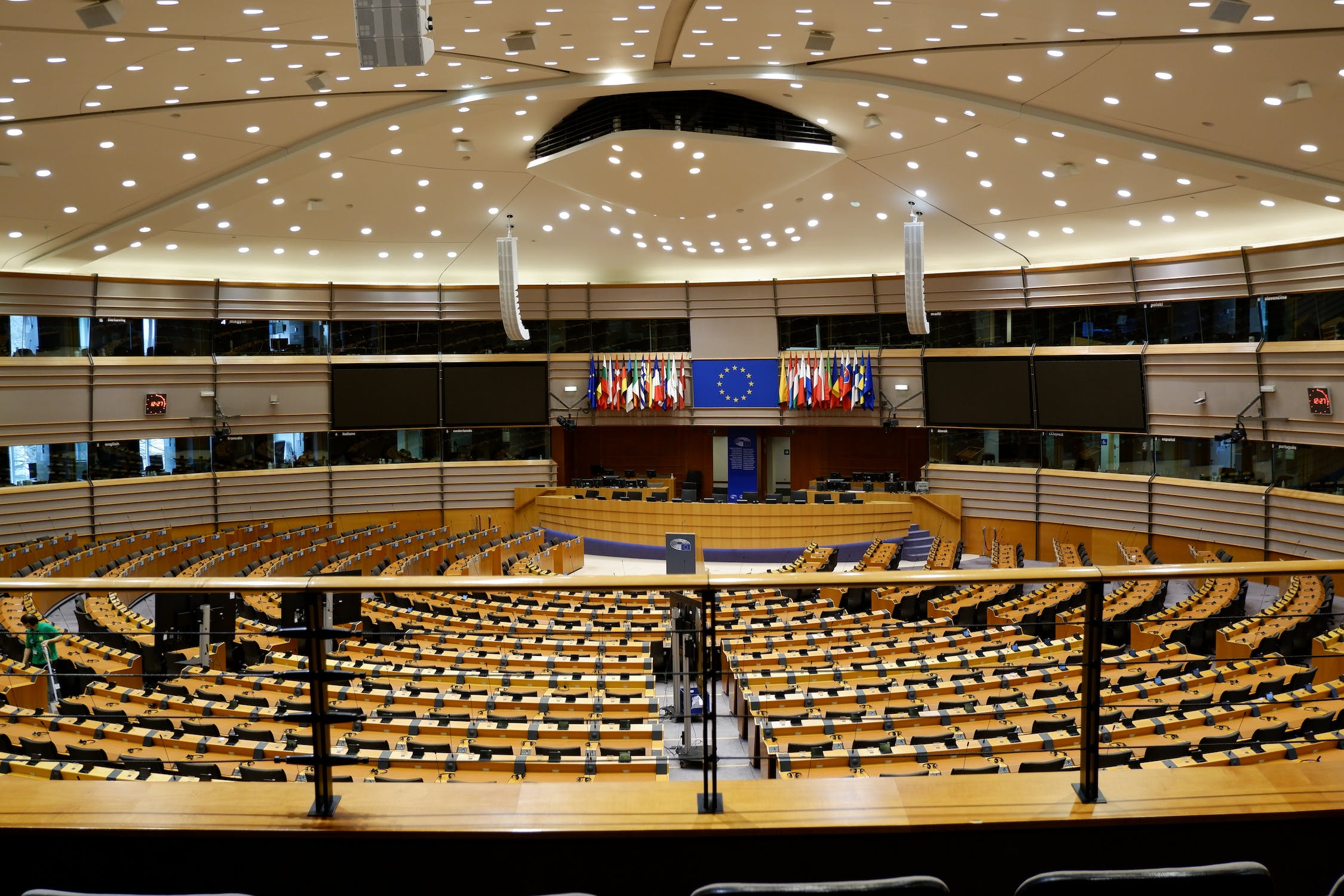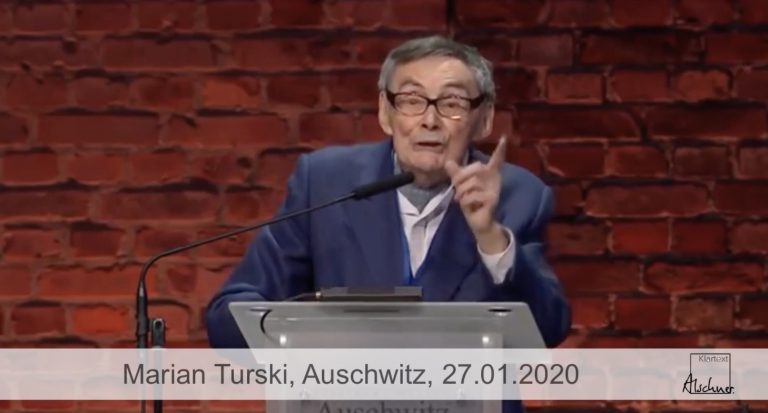Centralizing Information Control! Inside the EU’s Latest Proposal to Censor the Media
The European Commission proposed a new law seeking to centralize the EU media sector into a single market overseen by the Commission and national regulatory authorities through a new European Board for Media Services.
The European Media Freedom Act (EMFA), proposed by the Commission on Sept. 16, 2022, is portrayed as an effort to promote media independence and pluralism while safeguarding against disinformation and foreign interference in the media sector by establishing a set of standards in the form of EU law.
A core component of the EMFA is the establishment of the European Board for Media Services, which will consist of representatives from national regulatory authorities as well as a representative from the European Commission. It will be the duty of the Board to monitor the EU media sector, to issue opinions on market concentrations, to provide special advice and to ensure uniform compliance with the Regulation, among other tasks.
While the EMFA proposal has received some praise for its stated objectives – namely to protect media freedom – it continues to be scrutinized by various press organizations and members of the European Parliament for loopholes that would allow the surveillance of journalists while paving the way for unprecedented interventions in the internal media market by the European Commission.
Despite this criticism, the EMFA continues to progress through the EU legislative process. On June 21, 2023, the European Council secured a mandate for negotiations with the European Parliament. One month later, on July 20, the Committee on Civil Liberties, Justice and Home Affairs (LIBE) adopted its opinion on the proposed legislation, bringing the Regulation one step closer to becoming EU law as the Commission intends to conclude negotiations before the next EU elections.
The current framework
To understand the significance of the proposed EMFA Regulation, one must revisit the existing framework the EMFA will expand upon – The Audiovisual Media Services Directive (AVMSD). The AVMSD’s current advisory body to the Commission, The European Regulators Group for Audiovisual Media Services (ERGA), will be replaced by the new European Board for Media Services (the Board).
The current framework, the AVMSD, only applies to audiovisual media services, defined as “a service providing programmes, under the editorial responsibility of a media service provider, to the general public, to inform, entertain or educate, using electronic communications networks, either broadcast or on-demand.”
The EMFA, however, applies to the more broadly defined “media service provider” (MSP) which is described as “a natural or legal person whose professional activity is to provide a media service and who has editorial responsibility for the choice of the content of the media service and determines the manner in which it is organised.”
Therefore, this means that in contrast to the ERGA, the Board will oversee not only audiovisual media services but the press sector as well. The ERGA’s November 2022 position paper on the EMFA proposal suggested that the Board’s authority to regulate the press may be problematic for Member States.
“Given the sensitivity of press matters, as well as national specificities (including constitutional), ERGA wishes to explicitly and unambiguously state that it is neither its vocation nor its intention to regulate the press sector.”
Excerpt from the ERGA’s position paper on the EMFA
Ilias Konteas, Executive Director of the European Magazine Media Association (EMMA) and the European Newspaper Publishers’ Association (ENPS), whose legal specialization is in European media law, told Children’s Health Defense Europe that the Board’s competency over the press sector would undermine a core component of press freedom – the principle that the free press is solely responsible before the law and the courts for its content.
“The press should remain free from any European regulatory oversight,” said Konteas. “Since in the vast majority of Member States the press is self-regulated, the delegates in the Board would have tasks, at the European level, that are outside of their national mandate.”
Regulating the media, quite literally
The most apparent difference between the Audiovisual Media Services Directive (AVMSD) and the Proposal for a Regulation on the European Media Freedom Act (EMFA) is in the name itself. The current legislation, the AVMSD, is a directive, and had to go through national transposition and implementation, whereas the EMFA is a regulation, and will not be subjected to the same level of oversight by the European Parliament.
In the EU, there are several types of law: directives, regulations, decisions, recommendations and opinions. For the purposes of understanding the EMFA proposal, this section will briefly focus on the differences between a directive and a regulation.
A regulation is a type of EU law that sets an objective and defines how to achieve it. Once the law is adopted, it is effective immediately in all EU Member States. It is legally binding, supersedes national laws and Member States are limited in their ability to determine how to achieve the set objective.
A directive is a type of EU law that sets an objective but does not define how to achieve it. Member States may determine how to achieve the set objective through the establishment of national laws.
Executive Director Konteas says media policy has primarily been a competence of the Member States. “This triggered some debate on whether the Commission was allowed to propose a media regulation.”
History
The initiative for a new media freedom act was first mentioned by European Commission President Ursula von Der Leyen during her State of the Union speech in September 2021, in which she said, “Media companies cannot be treated as just another business. Their independence is essential. Europe needs a law that safeguards this independence – and the Commission will deliver a media freedom act in the next year.”
Several months later, in December 2021, the Commission announced a call for evidence for safeguarding media freedom in the EU, which was open to the public for feedback and consultation until March 2022.
In May of that year, the Commission constructed its impact assessment report and submitted it to the Commission’s Regulatory Scrutiny Board (RSB), whose duties are to provide “quality assurance,” support the Commission and provide assessments during the early stages of the legislative process.
It is worth noting that the RSB is portrayed as an advisory board to the Commission and is described as “an independent body,” according to its website. However, the RSB consists of nine members, five of whom are from within the Commission itself, including four high-level Commission officials and a Commission Director-General as the chair of the RSB. The remaining four members are recruited from outside the Commission.
One function of the RSB is to review and issue opinions on impact assessment reports. An impact assessment report must include the socioeconomic and environmental impacts of the initiative, who and what will be impacted by it and how, as well as the results of and the strategy taken during the consultation process.
The RSB may issue one of three opinions on an impact assessment report: “positive,” “positive with reservations” or “negative.” A proposed initiative may only be adopted if it receives a “positive” or “positive with reservations” opinion. If a “negative” opinion is issued, the draft report must be reviewed and resubmitted to the RSB.
Furthermore, it is important to consider that the RSB is a technical group, whose main function is to complete and verify impact assessment reports. In this instance, it is presumable that a key objective was to ensure that all areas within the internal media market were addressed and therefore subject to the Regulatory oversight of the Commission. The following section should be understood in this context.
Unpopular from the start?
Just one month after the Commission submitted its impact assessment report on the EMFA initiative, the RSB returned a negative opinion in June 2022.

The RSB’s initial opinion stated that the EMFA impact assessment report failed to explain the single market failures and the regulatory gaps. It did not explain with sufficient evidence the problems the EMFA seeks to address, how the measures will address these problems nor the prevalence of such problems across different media markets and Member States.
Furthermore, the opinion stated that the report did not clearly demonstrate the need for and effectiveness of certain measures and lacks transparency with regard to the stakeholders’ differing views during the consultation process.
Following the negative opinion, the Commission submitted a revised impact assessment report on July 11, 2022. Several weeks later, the RSB issued its second opinion: “positive with reservations.”
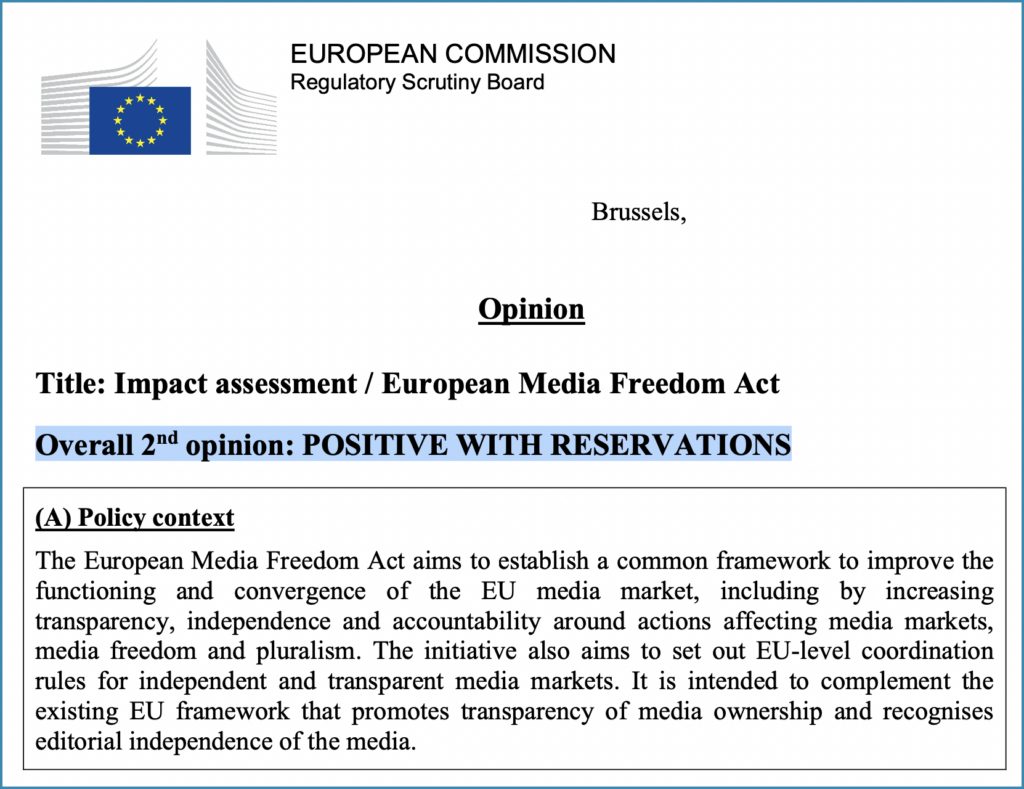
The second opinion stated that the revised impact assessment report of the EMFA still contained significant shortcomings, and in particular, it lacked the use of evidence to define or describe the problem it seeks to address. Additionally, the third point of concern read: “the analysis of single market and distributional impacts, among different media services and between Member States, is not sufficiently developed.”
Despite this, the Commission was able to proceed, and on Sept. 16, 2022, it published its proposal for “establishing a common framework for media services in the internal market,” which it named The European Media Freedom Act (EMFA).
The Explanatory Referendum of the EMFA draft legislation states the regulation “seeks to tackle a series of problems affecting the functioning of the internal market for media services and the operation of media service providers.”
According to the proposal, the EMFA will adhere to and expand on existing policies while addressing the regulatory gaps. Furthermore, it is constructed on four objectives:
1. “Fostering cross-border activity and investment in media services by harmonising certain elements of the diverging national media pluralism frameworks, in particular to facilitate cross-border service provision.”
2. “Increasing regulatory cooperation and convergence through cross-border coordination tools and EU-level opinions and guidelines.”
3. “Facilitating provision of quality media services by mitigating the risk of undue public and private interference in editorial freedom.”
4. “Ensuring transparent and fair allocation of economic resources in the internal media market by enhancing transparency and fairness in audience measurement and allocation of state advertising.”
The extended text on each of the four objectives may be read in the original draft EMFA proposal.
At first glance, the language used in the text of the proposal may instill a positive impression on the average EU citizen, resident, journalist, publisher or MEP. The use of phrases like “quality media services,” “fair allocation of economic resources,” “editorial freedom,” in addition to the name for the legislation, “European Media Freedom Act,” may suggest this proposal could empower and protect journalists and media professionals of various sub-sectors. That is, however, only in the absence of a closer look at the actual text.
Behind the fluff and buzzwords woven throughout the introductions, the media appearances and the speeches celebrating the EMFA proposal, in-depth examination of the text of the proposed Regulation unveils an unprecedented effort to establish a unified EU media sector under the central control of a newly established European Board for Media Services, which has the authority to censor and restrict the press.
A closer look at the EMFA
The Committee on Culture and Education (CULT) is the committee responsible for the EMFA. The Civil Liberties, Justice and Home Affairs (LIBE) and Internal Market and Consumer Protection (IMCO) committees serve as associates. The procedure is led by Special Rapporteur Sabine Verheyen, an MEP from the Christian Democratic Party of Germany.
Given that the EMFA proposal is still in the legislative process, there are several opinions and amended versions of the proposal. The subsequent text will analyze the Council’s negotiating mandate.
European Board for Media Services
(Author’s note: The bold text in the images indicate changes to the original draft EMFA proposal.)
The EMFA establishes the European Board for Media Services (the Board), which will replace the existing European Regulators Group for Audiovisual Media Services (ERGA). According to the Commission’s original EMFA proposal, the ERGA lacks the resources and ability to solve cross border issues, to manage regulatory matters and is limited in its scope of action.
The Board is portrayed as an independent body. Article 9 asserts “the full independence of the Board” and states that the Board “… shall neither seek nor take instructions from any government institution, person or body. This shall not affect the competences of the Commission or the national regulatory authorities or bodies in conformity with this Regulation.”
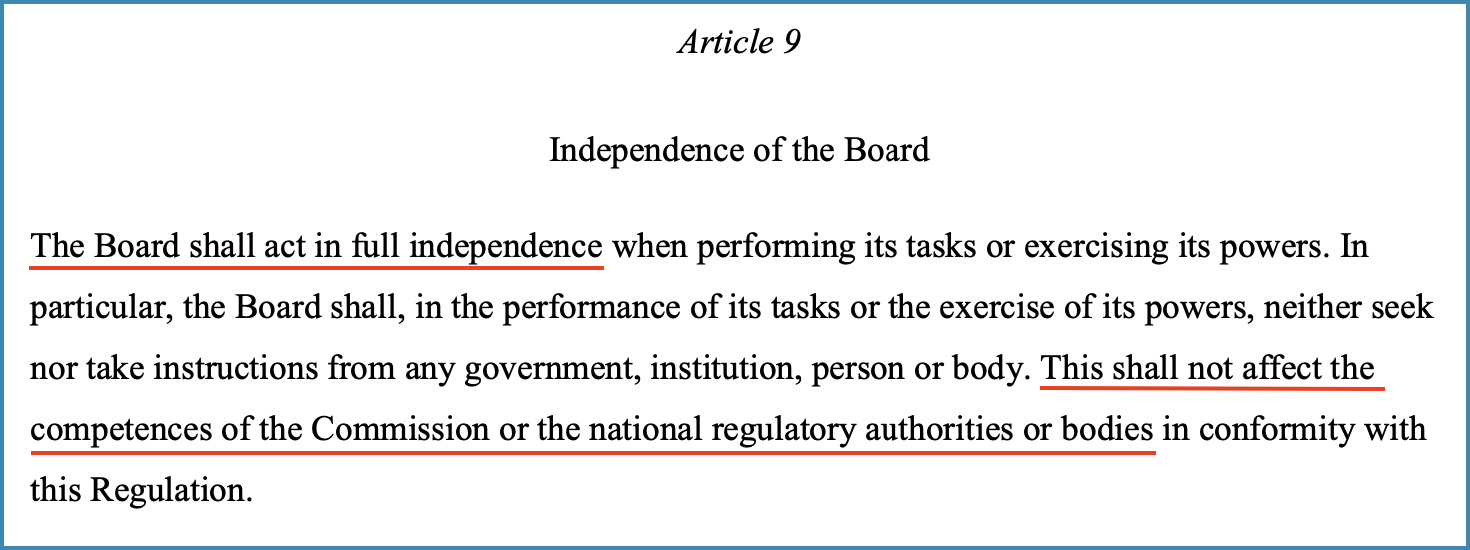
This means the Board shall act independently, however that independence shall not interfere in the areas in which the Commission and/or national regulatory authorities are, according to the legislation, involved in the Board’s functioning, management and execution of tasks.
On examination of the structure of the Board, its secretariat and its tasks, as described in Articles 10 to 12, it is clear that the Commission has a significant role in the Board’s operations and overall composition.
This has raised questions about the legitimacy of the independence of the Board asserted in Article 9. Even the ERGA’s position paper makes note of this contradiction in the following excerpt:
“The independence of the Board formulated in Article 9 is contradicted in practice by several provisions contained in the following articles on the internal functioning of the Board, the secretariat and the Board’s tasks.”
ERGA’s position paper on the EMFA
Structure of “the Board”
The Board will be composed of representatives from national regulatory authorities and each member will have one vote. A Chair and Vice-Chair will be elected by the Board members and may serve a maximum of two one-year terms. It will be the duty of the Chair to keep the Commission informed about the Board’s activities and to consult the Commission in preparation for its work programme.
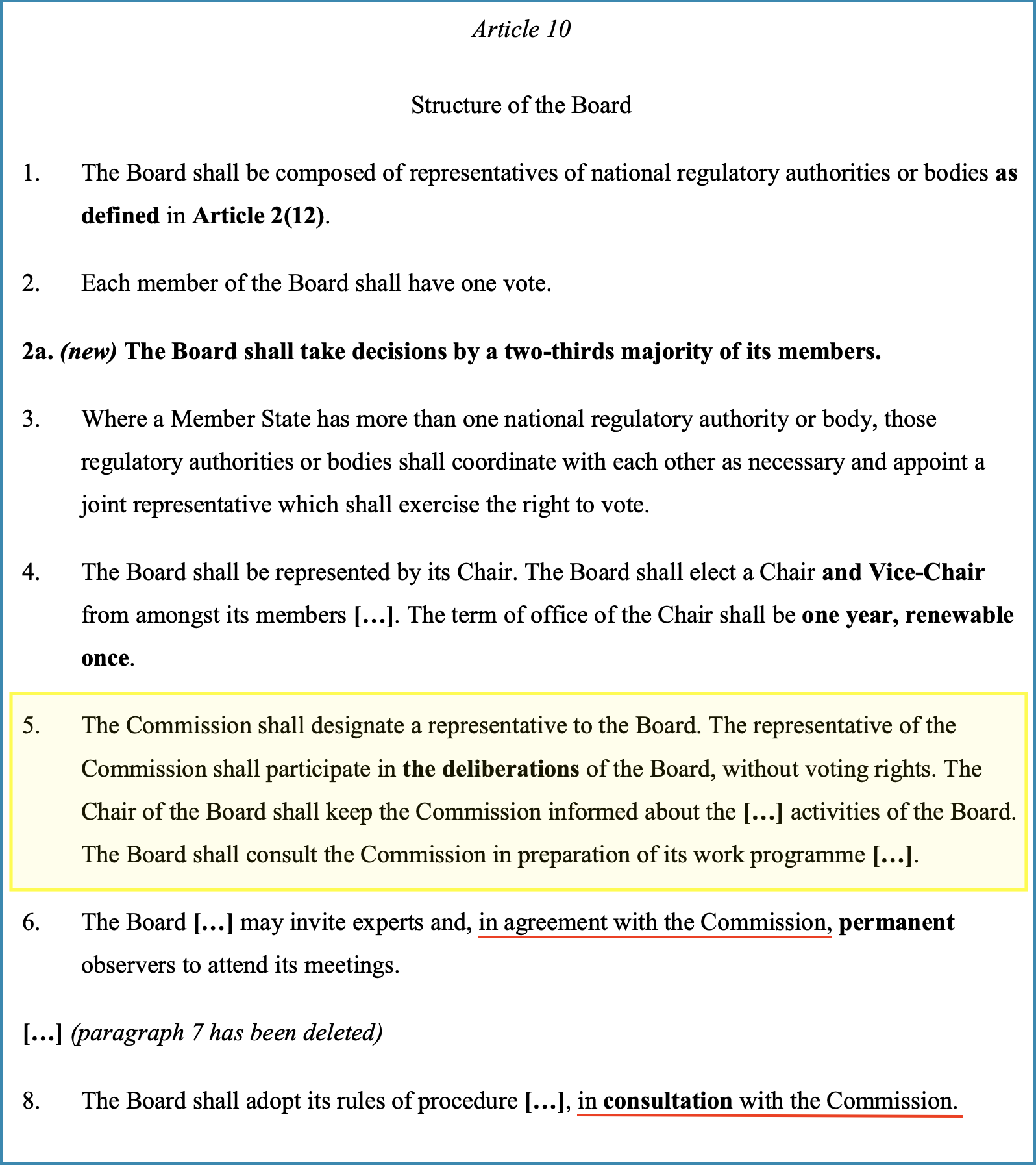
Additionally, the Commission will designate a representative to the Board who will participate in the Board’s “deliberations” but will not have voting rights.
“During an event a few months ago, the Commission said that they plan to assign eight to 10 people to the Board, which is quite significant even without voting rights,” said Konteas.
Furthermore, the Board must adopt its rules and procedure and the development of its work programme only after having consulted with the Commission. While the Board may invite experts to attend meetings, permanent attendees may only be permitted if the Commission agrees.
“If in any Member State, the government appointed a person to participate in all meetings and activities of the national media regulator, this would immediately ring some alarm bells for the risk of government interferences.”
Furthermore, even the staff of the Board is assigned by the Commission. As stated in Article 11, the secretariat will be provided by the Commission.

The Secretariat shall assist the Board with administrative and organizational activities and work closely with the Board and its Chair “drawing up on deliverables.”
However, the Committee on the Internal Market and Consumer Protection (IMCO), and The Civil Liberties, Justice and Home Affairs (LIBE) Committee opinions both seek to some what limit the role of the Commission.
Article 11 of the IMCO opinion removes the provision stating that the Secretariat shall be provided by the Commission, and instead states that “The Board shall be supported by an independent bureau.” However, both Committee’s uphold Article10(5), which allows the Commission to appoint a representative to the Board.
It will be determined during the later stages of the legislative procedure if such opinions will be adopted.
Tasks of the Board
Similar to the ERGA, the Board acts in an advisory and supportive position to the Commission. Unlike the ERGA, the Board has a much broader scope of competency and has regulatory authority over the press sector.
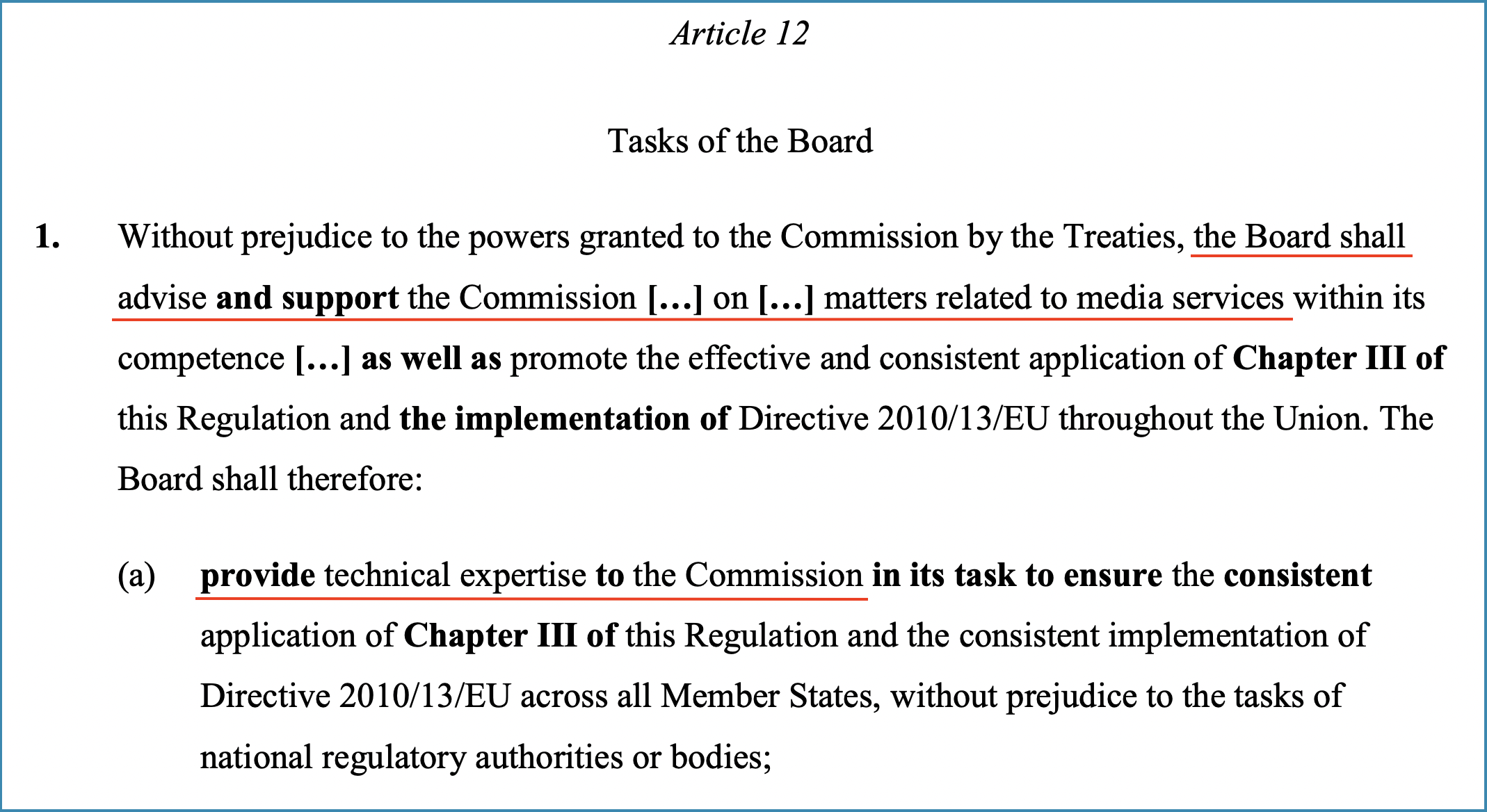
According to Article 12(1), the Board shall advise the Commission on media matters within its range of competence and promote and ensure the consistent application of the Regulation. The Commission is frequently referenced in the text of Article 12.
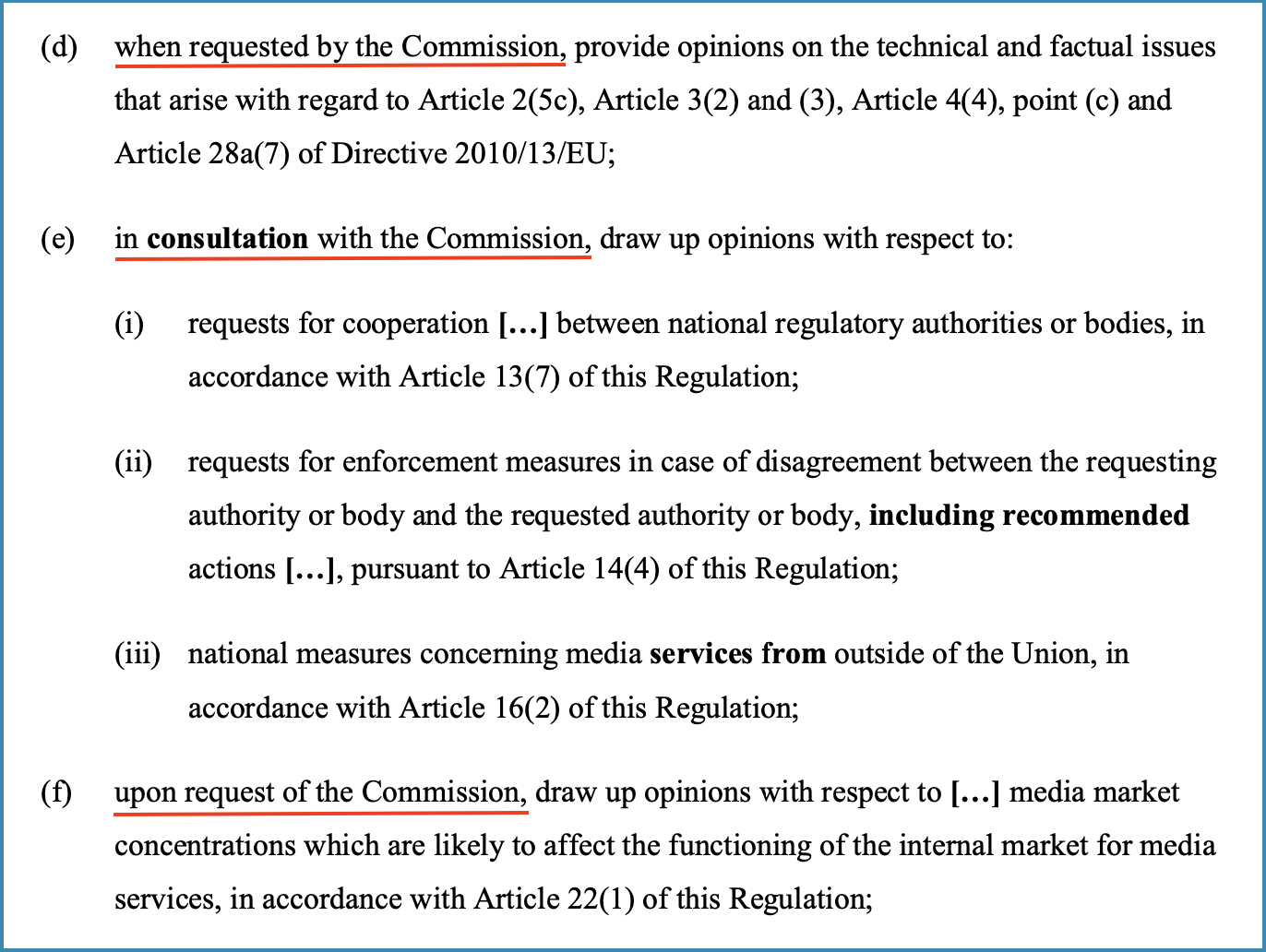
“When requested by the Commission” the Board shall provide opinions on technical and factual issues. “In Consultation with the Commission” the Board shall draw up opinions regarding requests for cooperation between regulatory bodies and requests for enforcement measures in case of a disagreement between natural regulatory authorities on national measures. “Upon the request of the Commission” the Board shall draft opinions on media market concentrations.
It is worth noting that while the ERGA’s position paper welcomes the new tasks given to the Board, it urges for a reduced role of the Commission:
“It is therefore inappropriate that the EMFA only or mainly provides for tasks of the Board to be executed either ‘in agreement with’ or ‘at the request of the Commission.’ The position paper requests that requests with ‘in an agreement to the Commission’ should be deleted.”
Excerpt from the ERGA position paper on the EMFA

Furthermore, as outlined in Article 12(h), it is the duty of the Board to merely “assist the Commission in drawing up guidelines with respect to the application of the Regulation” including Articles 23(1), (2), (3) and (4) as well as the factors to consider when assessing media market concentrations.
A new provision added by the Council allows for the Commission to place time limits when requesting advice or opinions from the Board.
The Board shall also offer mediation in the case of disagreements between national regulatory authorities and ensure the harmonization of standards related to design of devices or user interfaces. The Board will organize dialogue between very large online platforms (VLOPs) and media service providers (MSPs) and report those findings to the Commission to ensure the best practices for audience measurement systems.
One of the key objectives of the EMFA is to promote media pluralism. This raises questions as to how the Board will ensure news consumers have access to a wide range of opinions and perspectives from varying sources. An examination of Article 12(k) and Article 16 provide further insight into how the Board will manage media services established outside the EU.
A “serious and grave risk” to public security
In Article 12(k), it is a task of the Board to “coordinate national measures related to the dissemination of or access to content of media services from outside of the Union that target or reach audiences in the Union.”
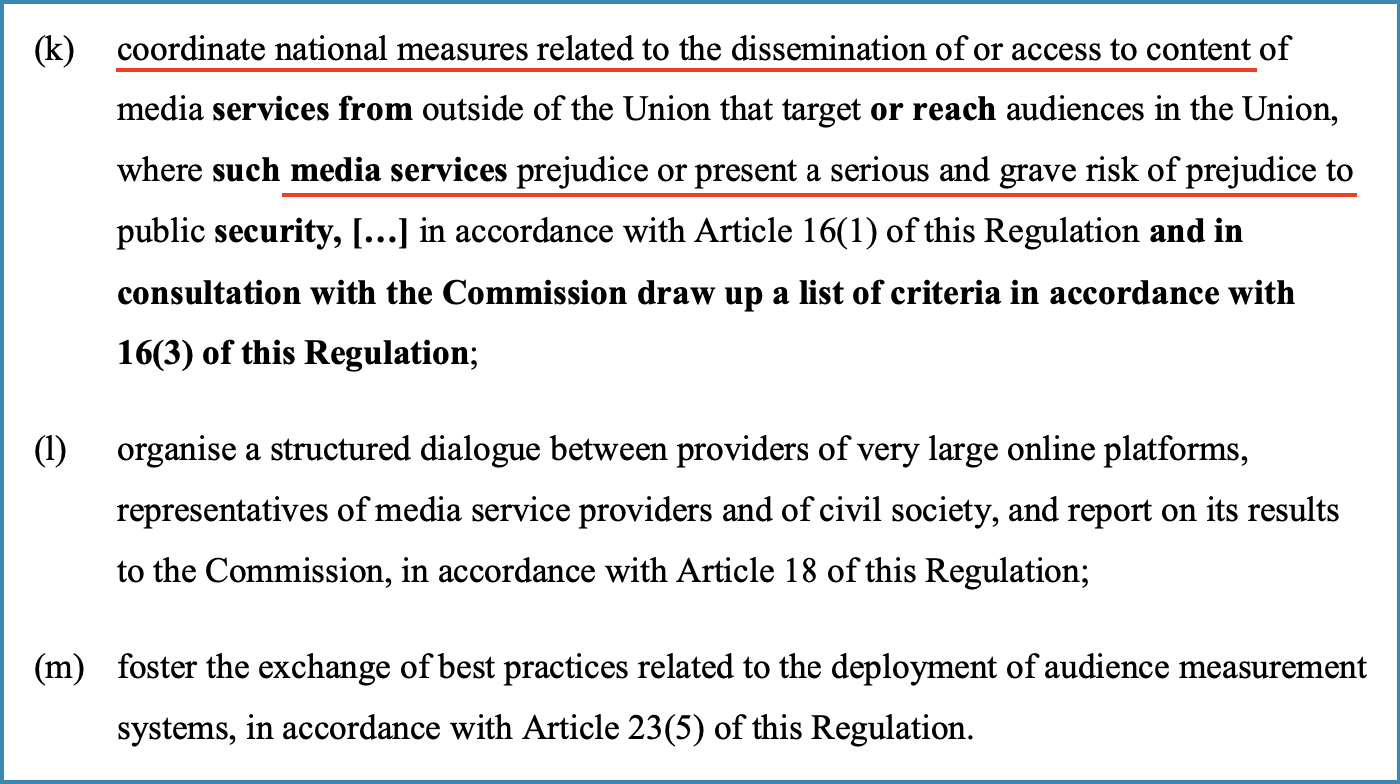
Therefore, the Board may limit or restrict access to content from media services outside the EU that target audiences within the EU through “national measures” if that media service is deemed “to present a serious and grave risk of prejudice to public security.”
If the Board, in consultation with the Commission, considers a media service from outside the EU to pose a “serious and grave risk” to the public, then news consumers within the EU may not have access to this content. While this is already happening with the banning of outlets like RT and Sputnik, the EMFA Regulation would provide a further legal basis for restricting access to content outside the EU that is deemed a threat to public safety and security.
This appears to be a key component of the EMFA, as outlined in Article 16.
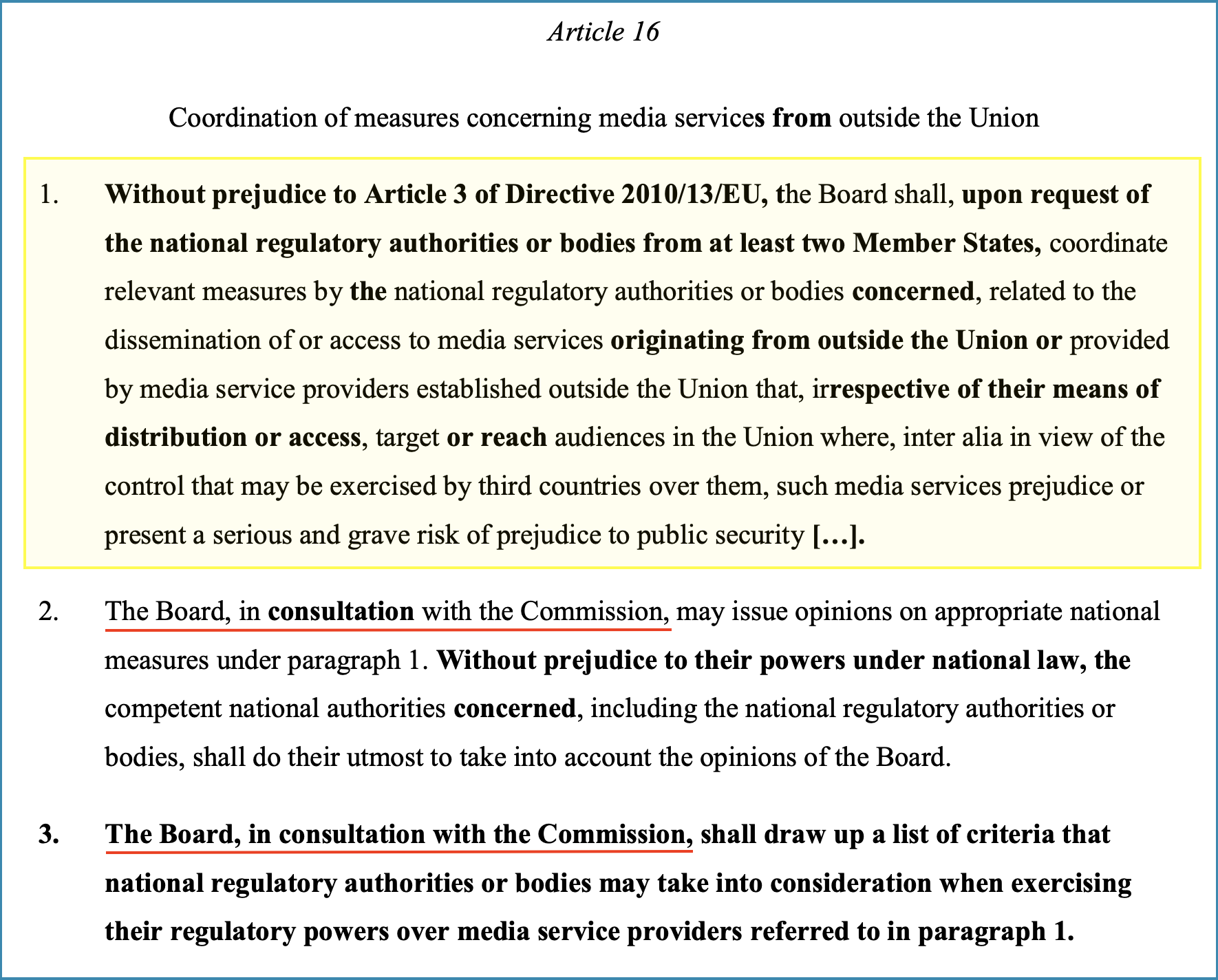
It states that media services or media service providers established outside the EU, “irrespective of their means of distribution or access, target or reach audiences in the Union where, inter alia in view of the control that may be exercised by third countries over them… present a serious and grave risk of prejudice to public security.” This indicates that by default, if a media service provider originates outside the EU, it is considered to be subject to control by third countries, and therefore is a risk of prejudice to public security.
Article 16(3) states that the Board, in consultation with the Commission, shall establish the criteria to be used by national regulatory authorities “when exercising their regulatory powers over media service providers.”
This is a clear admission that the national regulatory authorities monitoring the media sector at the direction of the Board and the Commission will have regulatory powers over media service providers.
In summary, while the Commission is concerned that media services originating outside the EU may present a risk to public security because they may be controlled by third countries, it simultaneously seeks to control the domestic EU media sector through the Board.
The great irony
Many organizations have expressed doubts over the EMFA proposal. Hundreds of press publishers and press publishers associations from various European countries have signed an open letter to the EU Co-legislators on June 27, 2023.
The open letter, which requests that the EMFA “lives up to its name,” addresses numerous issues with the proposal. It opens with a broad remark stating that several provisions of the EMFA are, in fact, counter-productive to protecting press freedom.
One of the many issues raised surrounds censorship, which has become a greater problem following the Digital Services Act (DSA), which gave social media companies and online platforms the right to remove and restrict content that does not comply with their terms and conditions.
“EMFA does not go far enough to safeguard freedom of expression and pluralism online and prevent censorship by very large digital platforms (VLOPs), that is becoming a widespread problem. The protection of freedom of expression must be considerably strengthened to guarantee the unfettered distribution of lawful European press content, and for pluralistic information to remain freely accessible online without undue interferences from VLOPs…”
Excerpt from the open letter, “The EMFA Must Live up to its Name”
More power to online platforms
Article 17 establishes the functioning and management of media service providers’ content in relation to the providers of very large online platforms (VLOPs). According to the original draft proposal, a VLOP provider is defined as “a provider of an online platform that has been designated as a very large online platform pursuant to Article 25(4)” of the DSA.
In April 2023, the Commission designated several entities, including but not limited to Amazon Store, Facebook, Twitter, YouTube, TikTok and others, as VLOPs.
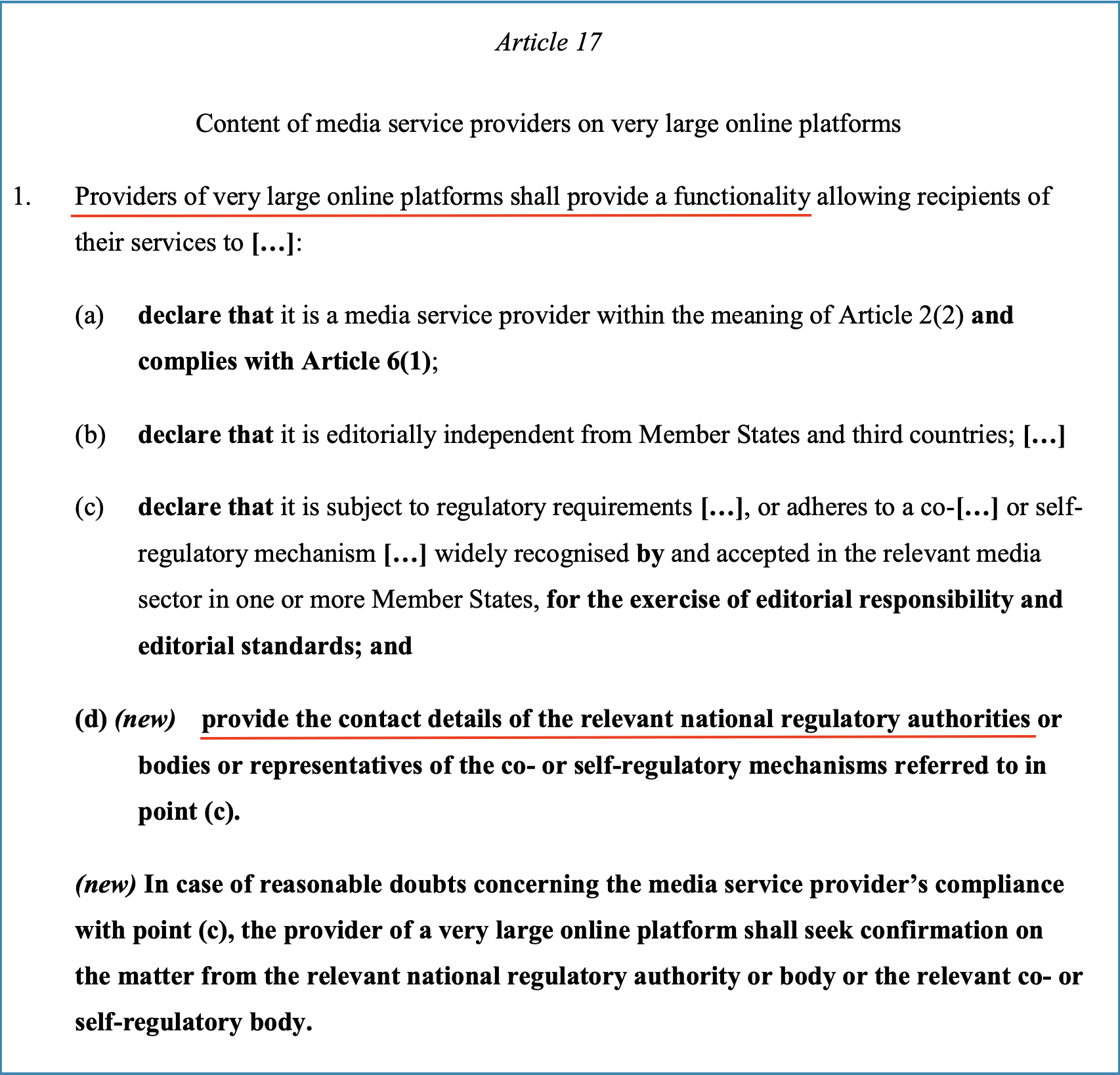
Prior to a media service provider (MSP) publishing content to a VLOP, it first must enter into a contractual agreement with the VLOP provider in which it confirms that it is an MSP, that it is editorially independent of Member States and third countries and that it is subjected to the regulatory requirements and complies with a co- or self-regulatory policy.
Unlike the original draft proposal, the Council’s negotiating mandate includes an additional provision which would require MSPs to provide the contact details of the relevant national regulatory authority, so in cases where an MSP is suspected to have not complied with point (c), the VLOP provider can contact the national regulatory authority for confirmation.
According to Article 17(6), “the Commission shall issue guidelines to facilitate the effective implementation of the functionality referred to in paragraph 1,” to ensure the consistent application of the article.

Therefore, MSPs must declare their independence from Member States and third countries while submitting to control and regulation by national regulatory authorities and the Commission via the Board.
“Any labelling and/or allowing VLOPs or ‘civil society organisations, fact-checking organisations and other relevant professional organisations’ to question media companies’ self-declarations is problematic as it allows third parties to restrict the rights of media companies,” said Konteas.
Suspensions, restrictions
If there were any doubts that providers of VLOPs would censor or restrict content, Article 17(2) makes it clear.
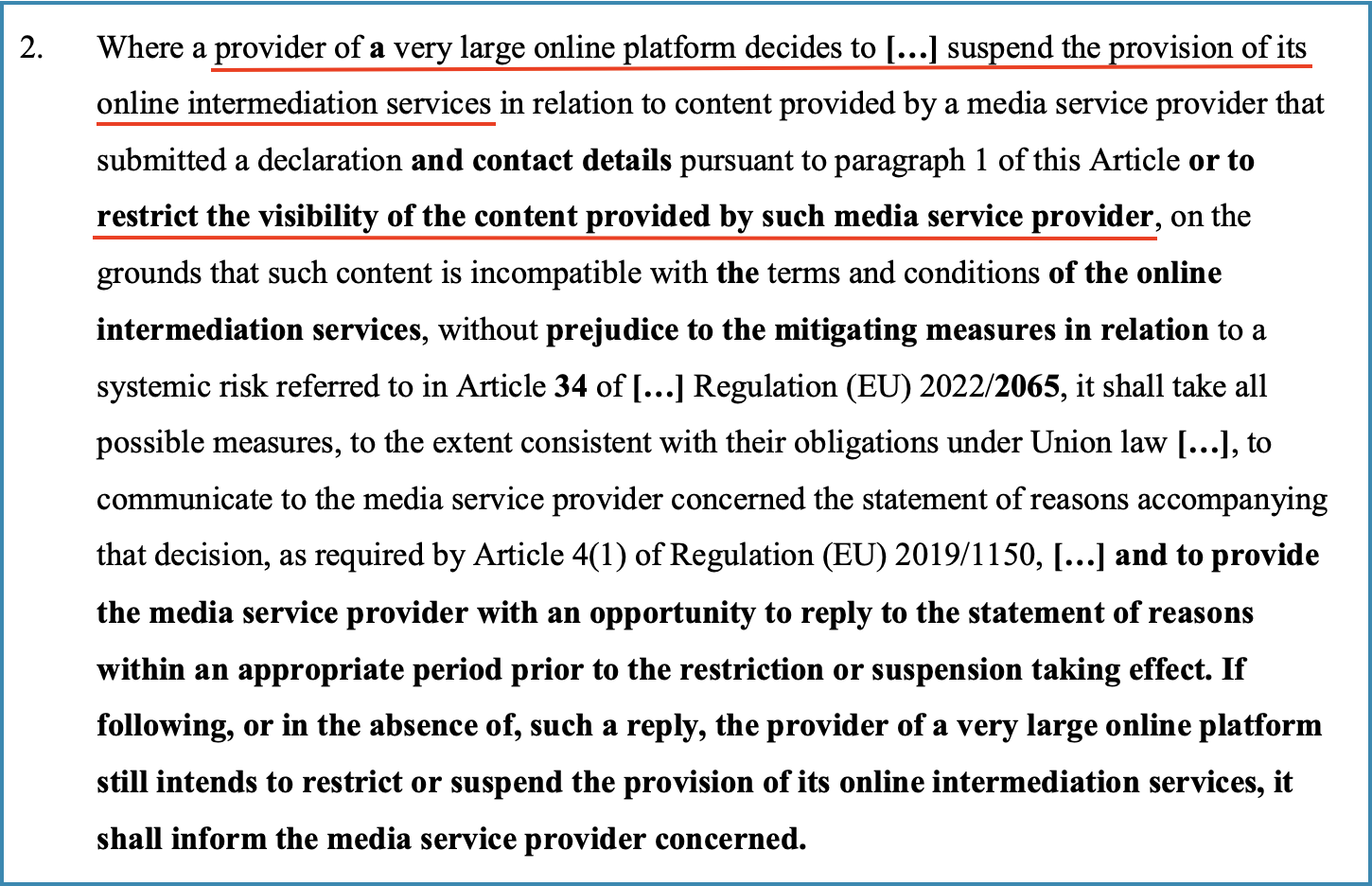
Providers of VLOPs will suspend MSPs for failure to comply with the Regulation and will restrict the visibility of content published by MSPs that is considered incompatible with its terms and conditions.
When this occurs, the provider of the VLOP must warn the MSP prior to the suspension or termination period and allow an opportunity for the MSP to respond. If an MSP considers that it has been repeatedly suspended without justification, the two parties must engage in a discussion about the matter in a timely manner, at the request of the MSP.
While it is unclear what specifics would justify suspension, restriction or removal of content, one can assume that MSPs deemed to produce “harmful” content and “disinformation” may be subject to repeated measures.
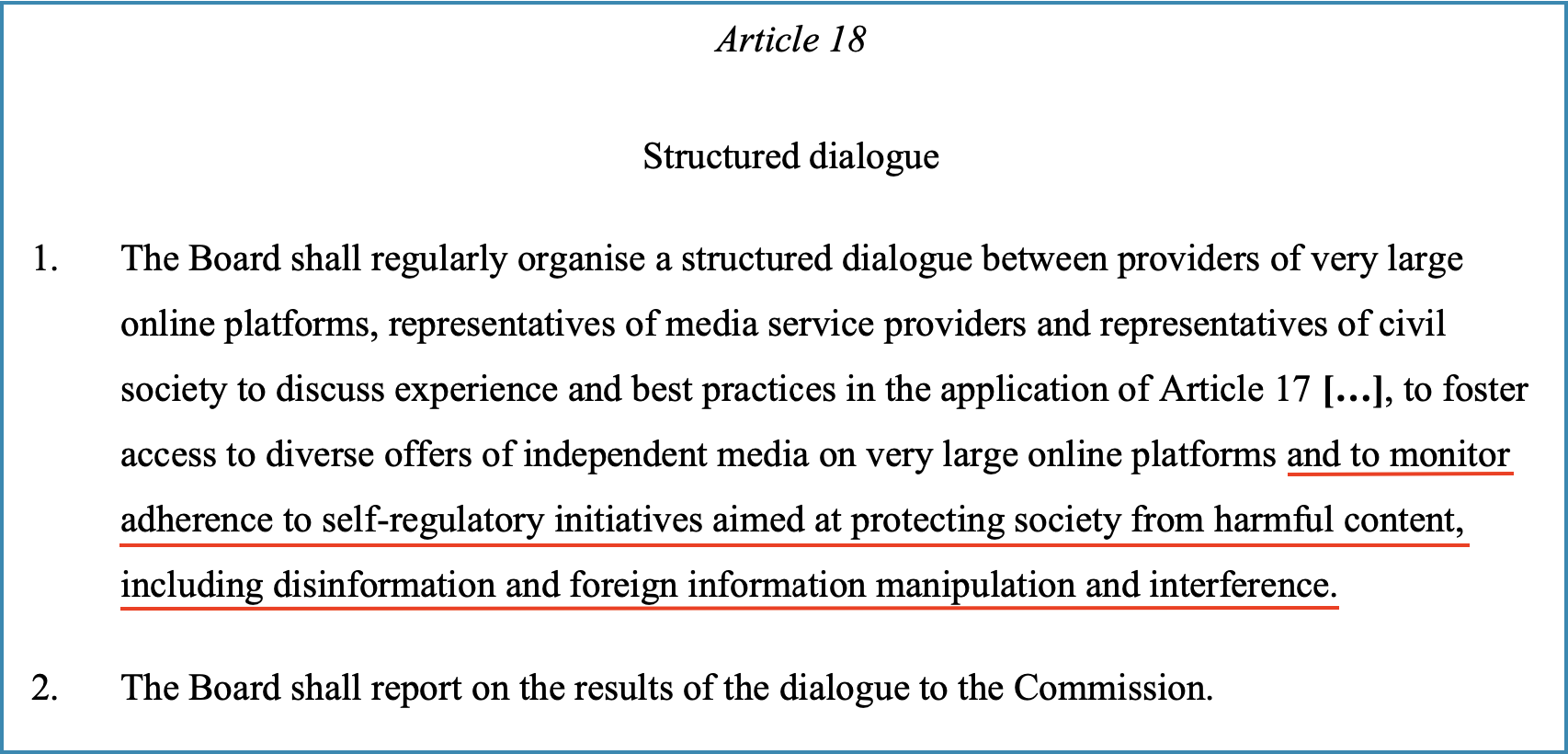
In Article 18, it states the Board shall meet regularly with providers of VLOPs, representatives of MSPs and members of civil society to ensure the best practices for the implementation of Article 17 “and to monitor adherence to self-regulatory initiatives aimed at protecting society from harmful content, including disinformation and foreign information manipulation and interference.”
What about media freedom?
While much of the EMFA seems to place further restrictions on MSPs and media services both within the EU and originating outside the EU, many may be left to wonder where the “freedom” in the European Media Freedom Act is.
Article 4 outlines the rights of MSPs and is the only article dedicated to this subject. It states that MSPs have a right to exercise their economic activities within the EU as long as the MSP complies with Union law. Member States must respect effective editorial freedom of media service providers and along with their national regulatory authorities must not try to interfere with or influence the editorial policies or decisions of MSPs and must respect the protection of journalistic sources.
Furthermore, Article 4(2a) addresses the rights of MSPs in the context of what Member States and national regulatory authorities must not do. Much of the controversy surrounding the EMFA is its loophole which allows Member States to spy on journalists, MSPs and their associations if deemed a national security threat.
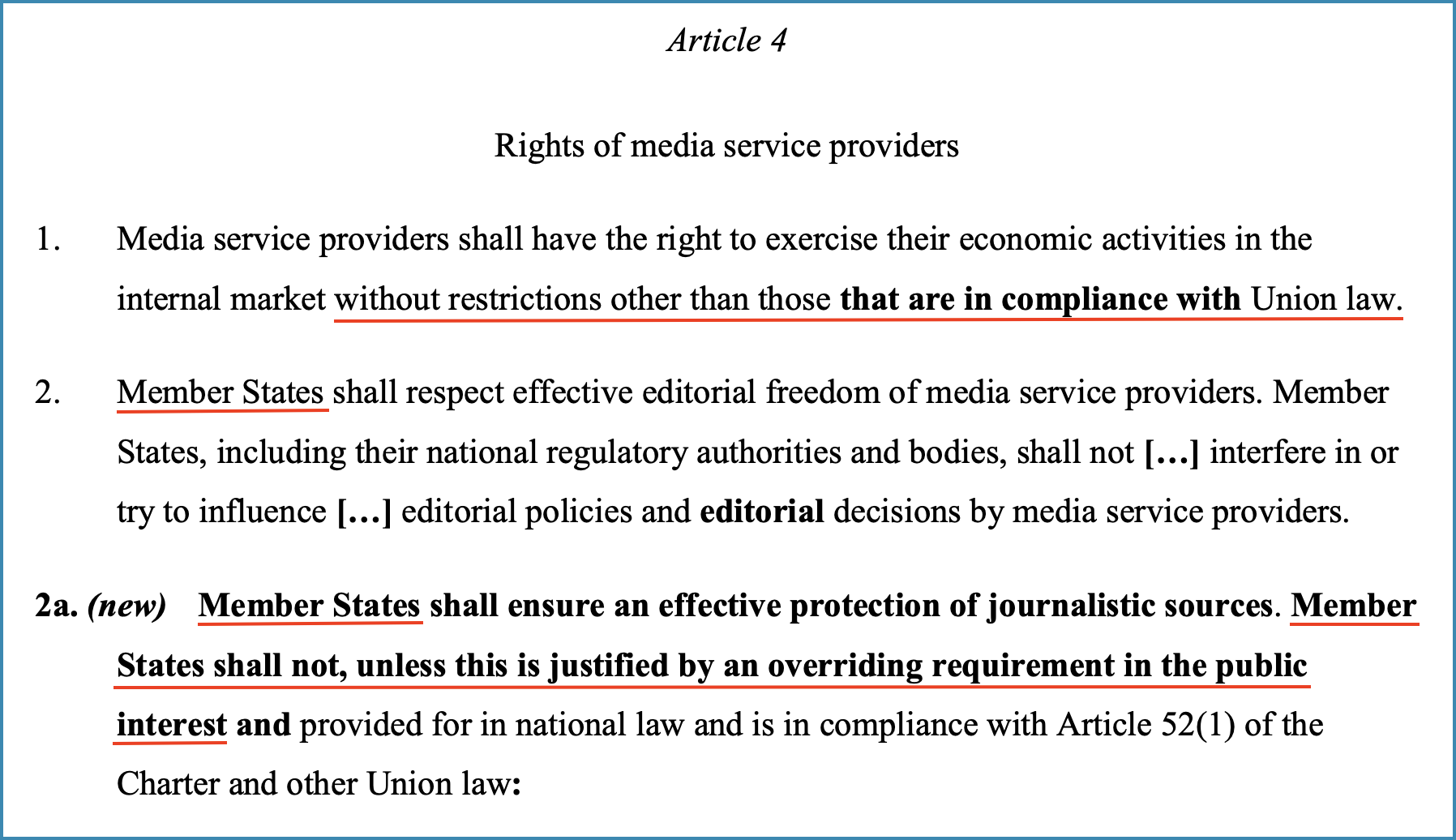
What is arguably one of the most overlooked aspects of the EMFA, is that MSPs are not provided protections from the potential abuses of power by the Commission and national regulatory authorities, which are given unprecedented controls over the media like never before.
“Once the risk of political pressure over editorial decisions has been acknowledged, it would be naïve to exclude the possibility that it might happen at European level,” said Konteas. On behalf of the EMMA and ENPS, he said that they are very concerned that there is no safeguard against the risk of interference by the Commission.
“In fact, we suggested to extend the protection of Art. 4(2), and especially of 4(2)(a), to potential threats coming from the European Union, its agencies and bodies, which should be just as bound to respect media freedom and independence as the governments and authorities of the Member States.”
In the context of the rights afforded to MSPs, the EMFA’s focus is to protect from potential abuses by Member States but not by the Commission, while reducing the role of Member States and granting significant authority to the Commission.
The prospects
If the EMFA were to be incorporated into EU law, one can only imagine the myriad of ways in which the EU media sector would change. A once self-regulated sector would then come under the control, albeit indirectly, of the European Commission, an unelected and largely unaccountable body.
“Europe is a diverse region. Europe has always relied on the diversity of its culture, on its geographical diversity, on its linguistic diversity and the media markets across the Union have been built on these elements. So we don’t feel that there is one common market that justifies the regulatory intervention by the European Commission … The supervision from a central authority, this European Board, is unprecedented for our sector. What we feel is also problematic is the direct involvement of the European Commission. It’s like you have a European government supervising the media. I don’t think this fits very well.”
Excerpt from Ilias Konteas during a debate on France24, November 2022
The Commission, via the Board and national regulatory authorities, seeks to monitor the media, yet it is the job of the media to monitor them. While the EMFA Regulation would apply to any person or entity who meets the criteria for the broadly defined “media service provider,” it is important to consider how the field of journalism, which is intended to be a check on the powerful, will be affected.
A journalist’s duty is not to any government, governmental body or corporation. A journalist’s duty is to the public. This very principle, that has for so long been cherished, could be greatly jeopardized if the EMFA becomes law, especially in its current form.
Yet, the EMFA does not just include provisions that restrict and control journalists and “media service providers,” it also seeks to control you – the reader, the consumer of news.
During the past three years, the language of public health was used to destroy our health under the guise of protecting our health. Now the language of media freedom is being used to control and destroy the media under the guise of protecting the media.
The EMFA will regulate your access to information, under the guise of protecting you from “harmful disinformation” and “foreign manipulation.” Should the European Commission and the European Board for Media Services determine what it is true or what is false, what you should read or what you should not watch? You, the reader, should be left to decide that on your own.
The Committee on Culture and Education (CULT) is expected to issue its opinion on the proposal in September of this year, and then it will enter into a trilogue negotiation with the Council. The Commission, Parliament and Council all seek to conclude negotiations on the EMFA Regulation before the European Parliament elections in Spring 2024.
(Author’s Note: MEPs Gwendoline Delbos-Corfield and Sabine Verheyen were both contacted for a comment but did not respond.)
Suggest a correction

